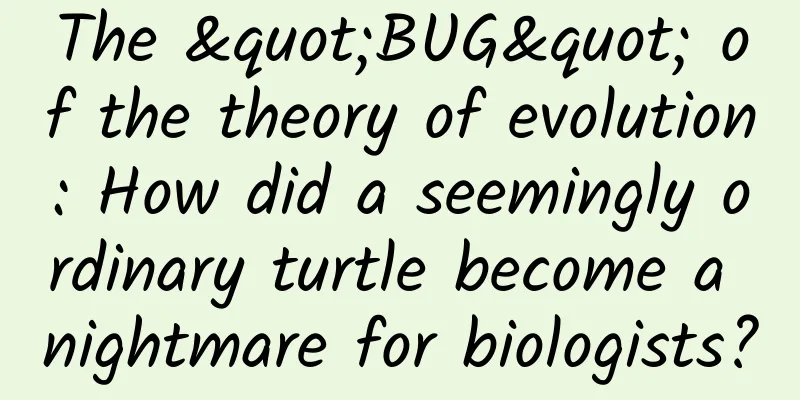The "BUG" of the theory of evolution: How did a seemingly ordinary turtle become a nightmare for biologists?

|
In 1859, a book that had a profound impact on the biological community was published. It not only laid the foundation for the study of biology, but also seriously shook the theological rule at the time. This book is "The Origin of Species". In this book, Darwin discussed the theory of biological evolution in detail and challenged the religious creation theory. He believed that all living things were not like this at the beginning, but gradually evolved into what they are today in order to survive better as the environment changed. Darwin and The Origin of Species The theory of "biological evolution" can be said to have pioneered modern biology and has had a profound impact on disciplines such as genetics, molecular research, and geological research. As biological research becomes more and more in-depth today, scientists are still moving forward along the direction of biological evolution proposed by Darwin two hundred years ago, and have reaped great rewards on this road. They have gained a deeper understanding of life on Earth, gradually mastered the evolutionary process of existing organisms in the world, and allowed those organisms that have disappeared in the history of evolution to see the light of day again, allowing people to have a better understanding of the ancient life on Earth. The theory of "biological evolution" pioneered modern biology However, it is not always smooth sailing on this road. There are always some creatures that give biologists headaches. For example, the turtle, which is nicknamed "evolution bug" by netizens, has become a nightmare for scientists. Why does the turtle give scientists such a headache? Let's talk about it in detail. The birth of life As an important planet in the solar system, the Earth had no life at the beginning of its birth. However, 4.5 billion years ago, when a comet visited the Earth, the Earth began its long journey of life evolution. It can be said that this comet opened the door to life for the Earth. Comet "visits" Earth After a long time of 100 million years, the first single-nucleate organisms evolved into more advanced life - single-celled organisms. After another long evolution, eukaryotic life finally appeared 2.7 billion years ago, and the carnival of life has just begun. 500 million years ago, life on Earth ushered in a development frenzy, known as the Great Explosion of Life. The creatures of this period were all kinds of strange and varied, and people wondered whether the strange-looking animals in China's "Classic of Mountains and Seas" were described according to the appearance of creatures of this period. Evolution of Life It was not until the Triassic mass extinction that this carnival of life was gradually curbed, and after the development and reproduction of life on Earth, the Earth was no longer silent, but gradually became lively. With the development and progress of geological survey technology and archaeological technology, biologists have a deeper understanding of that distant era, and have further explained the evolution of life on Earth today. It’s just that in this process, turtles are an exception. Every time scientists think they have found real and reliable evidence to prove the evolution of turtles, but every time the hypothesis is overturned. Turtles are amphibians of the family Testudinidae. They mainly live in waters such as rivers, seas, and lakes. They are omnivorous animals. When we talk about turtles, the first thing that comes to our mind is the turtle’s long lifespan, slow speed, and the behavior of directly retracting its limbs and head into the shell when in danger. And it is this turtle shell that has become a mystery that has not yet been solved in the biological community. What’s going on? Turtle in the pond Puzzling bug - turtle shell First, let's talk about the turtle's shell. I believe many people don't know what a turtle shell looks like. The shell on the back of a snail is just a shell connected to the body, not a part of the body skeleton. Unlike the shell on the back of a snail, the turtle's shell is actually made of the turtle's bones. It is a layer of hard shell formed after the ribs and chest cavity are closed. If you perform an autopsy, you will find that you can see the turtle's internal organs after removing the shell. Among various crustaceans, their shells are mostly made of stratum corneum, and a few are evolved shells, such as pangolins, but among these crustaceans, a turtle's shell is made of bones, which is really unheard of. Cute little turtle Generally speaking, important parts of the body like bones should be protected. How can they grow outside the body? It's like if the heart doesn't grow in the chest but grows outside the body, can it survive? The situation of the turtle obviously violates the common sense of biological survival and reproduction. Scientists are also puzzled by this and hope to find the answer from those ancient fossils. According to Darwin's theory of evolution, the evolution of biological morphology is inseparable from the environment, which means that it must be due to environmental factors that the ancestors of the turtle chose this incredible way of evolution. Scientists initially speculated that turtles have shells for defense, to prevent predators from harming them, but this speculation is obviously untenable, because turtles pay the price of speed, and slow movement means they die faster, right? At this time, new progress has been made in paleontological fossils. Fossil Discovery In 1887, humans discovered a peculiar fossil. After identification, it was found to be a turtle fossil from more than 200 million years ago. Scientists named it Protochelys. Restoration of the original jawed turtle Since Protojaw turtle has the same shell as modern turtles, it is considered to be the ancestor of modern turtles. This discovery confirmed one thing for scientists: turtles had shells much earlier, so they turned their attention to Sawtooth Dragon. Sawtooth Dragon lived 290 million years ago, a little earlier than Protojaw turtle. Its walking style is similar to that of turtles, and it also has a stacked armor on its back. Scientists believe that Protojaw turtle evolved from Sawtooth Dragon. Sawtooth Dragon Model But this conclusion did not last long. In 2008, another turtle fossil appeared in Guizhou, my country - Odontochelys semi-carapaceous turtle, which appeared about 10 million years earlier than Protochelys and looked like a half-evolved turtle. What surprised scientists even more was that its shell grew on its abdomen. Scientists had to give up their original idea and believed that Odontochelys semi-carapaceous turtle evolved from Protochelys semi-carapaceous turtle. Image of a half-carapace turtle Soon, an even older turtle fossil was discovered - the Zhengnan turtle. The Zhengnan turtle lived about 280 million years ago, and was older than the semi-carapace turtle. It had not yet evolved a turtle shell. Later, a fossil called the Ancestor turtle was discovered in Germany. It existed later than the Zhengnan turtle, and its abdomen had a tendency to evolve into a plastron. So an evolutionary chain was proposed by scientists, from the Zhengnan turtle to the Ancestor turtle, then to the semi-carapace turtle, then to the Protochelys, and finally to today's turtles, as if this was the final answer. Restoration of the Zhengnan Turtle However, the latest findings of molecular biology have directly overturned this conclusion. By analyzing and comparing the genetic maps of all reptiles, molecular biologists pointed out that turtles, birds and crocodiles are very closely related. They should have a common ancestor - a diapsid reptile, while the Euonymus sempervirens is an anapsid. 280 million years ago, when the Euonymus sempervirens lived, these three types of animals had not yet evolved separately. In other words, at that time, the true ancestor of turtles should have the characteristics of birds and crocodiles, which conflicted with the existence of the Euonymus sempervirens. Scientists could only overturn the original hypothesis. Modern turtle shells and turtle fossils While scientists were arguing over what the ancestor of turtles looked like 280 million years ago, a new turtle fossil appeared in China - the Protochelys, which lived 228 million years ago, between the Ancestor Turtle and the Odontochelys. The amazing thing is that it has no tortoise shell. Whether it is the Odontochelys or the Ancestor Turtle, did the Ancestor Turtle evolve into a tortoise shell, but halfway through evolved back to the Protochelys? And finally evolved an abdominal tortoise shell to become the Odontochelys? New hypothesis Scientists are still tirelessly studying the ancestors of turtles, hoping to find the correct evolutionary path. The latest theory is the convergent evolution hypothesis, which has been generally recognized by scientists in the biological community. Scientists proposed the hypothesis of convergent evolution Convergent evolution means that in the process of evolution, although there is no close blood relationship between organisms, due to similar environments and similar evolutionary pressures, completely different organisms will evolve similar characteristics. Scientists believe that although the ancestors of turtles should have the characteristics of crocodiles and birds 280 million years ago, under the theory of convergent evolution, it is understandable that the ancestors of turtles appeared in different appearances in the same period in order to adapt to the environment. Little turtle looks up So is this hypothesis really the final answer? Maybe in the future, as new turtle fossils are discovered, we will come up with new hypotheses, or prove that this hypothesis is correct. Source: Cosmic Decoding |
>>: Can we genetically modify pests to make them 're-insects'?
Recommend
Qingming Outing Season | Want to go outing and learn knowledge during the Qingming holiday? Why not go see the "Kidney of the Earth"?
Audit expert: Yang Yanhui Senior Landscape Engine...
Japan's "Xiang Xiang" and the United States' "Ya Ya" return to China! How difficult is the road to protecting giant pandas?
There were numerous banners, fans were crying wit...
Unleash your potential
Introduction to resources to ignite the potential...
Finally supports personalized ringtones and HD videos! WeChat new version experience
WeChat has been updated. In this update, we can f...
Basic optimization of Shenma advertising keywords!
In search promotion, after advertisers have deter...
After watching "Your Name." 》After reading this, I have three thoughts on copywriting
Makoto Shinkai's new work "Your Name.&qu...
Will acquired changes affect gene inheritance?
The reason why humans have been able to reproduce...
Wild boars appear frequently, but cannot be killed at will. How do wild boar hunters do their job?
Wild boars are rampant in many parts of my countr...
How can iOS be reliable in recruitment?
I have interviewed many people in the past year. ...
At the end of September, the number of 5G mobile phone terminal connections in China reached 445 million
This year, China has accelerated the construction...
A review of the top ten crisis public relations events in 2020
2020 has been a year of ups and downs, and the sa...
How much does a four-day tour to Hong Kong and Macau cost?
If you travel independently, all the expenses wil...
How to use Tik Tok to promote and disseminate short video advertisements?
Any place with traffic is a suitable advertising ...
Duang! A complete collection of self-study Android materials
[[128183]] Text/Tikitoo I have learned Android fo...
How to write a valuable competitive product analysis report?
Before writing a competitive product analysis rep...









